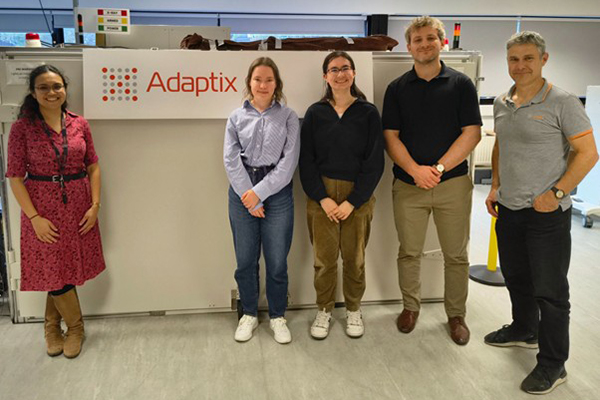LIV.INNO researchers visit Adaptix for OptiX project collaboration

Researchers from the University of Liverpool's QUASAR Group recently travelled to Begbroke Science Park in Oxford for a collaborative visit with Adaptix Ltd, their industry partner in the development of next-generation 3D X-ray imaging technology.
Dr Alexander Hill, LIV.INNO fellow, and Dr Daliya Aflyatunova made the journey to Adaptix's offices to meet with the wider team and advance their joint work on the OptiX project. The visit provided an opportunity for face-to-face discussions with key Adaptix personnel, including CTO Steve Wells, Principal Scientist Aquila Mavalankar, and Senior Imaging Scientist Ishbel Jamieson. LIV.INNO PhD student Lauryn Eley, who is currently on long-term attachment at Adaptix, joined the discussions.
A highlight of the visit was the chance to observe Adaptix's existing digital tomosynthesis (DT) devices firsthand. The Liverpool researchers were able to see both orthopaedic and non-destructive testing (NDT) setups in operation, providing valuable context for their computational modeling work.
"Seeing the devices in action gave us a much firmer understanding of what we're actually simulating," explained Dr Hill. "It's one thing to model X-ray beam interactions computationally, but quite another to witness the physical systems performing real imaging tasks. This kind of direct experience is invaluable for refining our approach."
The visit centred on discussions about how the Liverpool team's simulations are supporting Lauryn Eley's ongoing experimental campaign into the design and development of DT devices for both medical and industrial applications. The SCIMITAR framework, recently published by Dr Hill and colleagues in Biomedical Physics & Engineering Express, provides the computational foundation for virtually designing and optimising Flat-Panel Source (FPS) based imaging systems.
The teams also looked ahead to future research directions, exploring possibilities in feature detection within images and developing robust methods for image quality quantification. These discussions reflect the maturing nature of the collaboration as it moves from fundamental device optimisation toward clinical and practical deployment considerations.
The visit represents continued momentum for the OptiX project, a £400k initiative funded by the Science and Technology Facilities Council (STFC) under UKRI's Late-Stage Commercialisation Scheme. The project aims to deliver advanced 3D chest imaging directly at the patient's bedside using Adaptix's innovative FPS technology, which offers the potential for low-dose, portable imaging without the mechanical complexity and higher radiation exposure of conventional CT systems.
Dr Hill reflected on the visit: "This was a wonderful opportunity to see the fruits of our collaboration in action. The integration of our simulation work with Adaptix's cutting-edge hardware is progressing brilliantly, and it's clear we have much exciting work ahead of us. The partnership between academic research and industrial innovation is really driving this project forward."
The collaboration between the QUASAR Group and Adaptix, supported by the LIV.DAT and LIV.INNO Centres for Doctoral Training, continues to demonstrate the value of sustained, cross-sector partnerships in translating fundamental research into real-world medical technology.
With Lauryn's embedded presence at Adaptix and regular exchanges like this visit, the OptiX team is well positioned to deliver on its ambitious goal: a clinically deployable 3D X-ray imaging solution that is safer, faster, and more accessible than current alternatives.